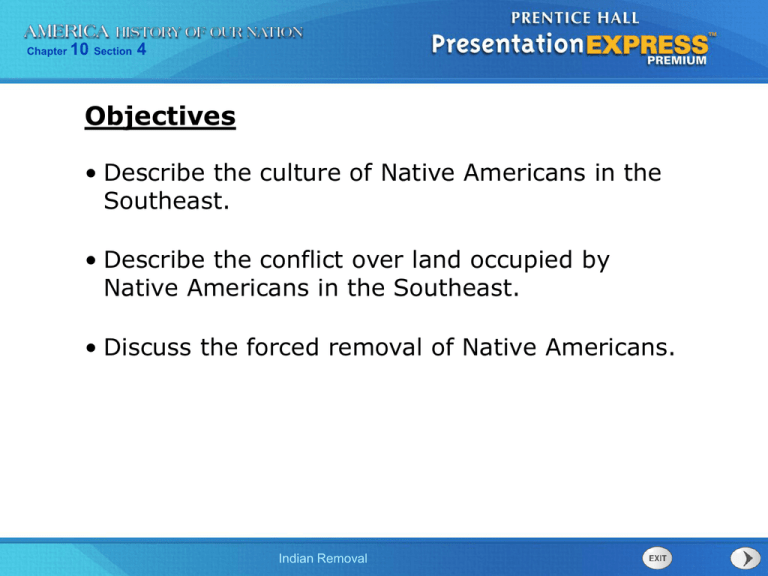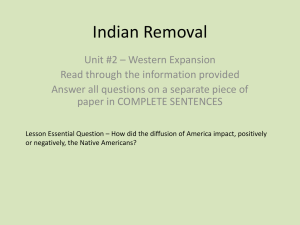Section 4 PowerPoint Notes
advertisement

Chapter 10 Section 4 Objectives • Describe the culture of Native Americans in the Southeast. • Describe the conflict over land occupied by Native Americans in the Southeast. • Discuss the forced removal of Native Americans. Indian Removal Chapter 10 Section 4 Terms and People • Sequoyah – Cherokee leader and creator of the Cherokee alphabet Indian Removal Chapter 10 Section 4 Set Questions: 1. List three Native American tribes that were relocated by the United States Federal Government. 2. Why did the US Government want the land? 3. How were the Cherokee’s different from other Native American tribes? 4. What act gave Jackson the power to remove the Native Americans? See Pages 355-359 in your book Indian Removal Chapter 10 Section 4 Why did Jackson use force to remove Indians from the Southeast? Beginning with President Jefferson, there had been attempts to move Native Americans westward. Jefferson hoped Native Americans would move voluntarily to preserve their culture (way of life). Indian Removal Chapter 10 Section 4 After the War of 1812, Native Americans in the “old” Northwest gave up their lands and moved west of the Mississippi River. However, the Native Americans living in the Southeast refused to move. Indian Removal Chapter 10 Section 4 To government leaders, the tribes of the Southeast stood in the way of westward expansion. tribes American settlement Fertile farmland By the 1820s, many southerners were demanding that the government move the tribes by force. Indian Removal Chapter 10 Section 4 The pressure on Native Americans grew. 1825 President Monroe created a plan to move all Native Americans west, but it failed. 1827 The state of Georgia forced the Creeks to give up most of their land. 1828 Georgia tried to force the Cherokees to give up their lands. Indian Removal Chapter 10 Section 4 Georgia’s actions were challenged in two Supreme Court cases. Cherokee Nation v. Georgia Worcester v. Georgia The Federal Government could not stop Georgia from enforcing their laws. However, Georgia’s laws “can have no force” in Cherokee territory. Indian Removal Chapter 10 Section 4 In Worcester v. Georgia, Chief Justice John Marshall quoted treaties signed by the United States. The treaties granted territory to the Native Americans. Marshall said that Georgia did not have the right to revoke treaties made between two sovereign nations. Indian Removal Treaties between the Georgia’s United laws States and the Native Americans Chapter 10 Section 4 President Jackson opposed the Supreme Court ruling in Worcester v. Georgia. In 1830, Jackson put a new federal law into effect. Indian Removal Act The act gave Native Americans land in the West in exchange for their lands in the East. Indian Removal Chapter 10 Section 4 When Andrew Jackson became President in 1829, more than 100,000 Native Americans lived east of the Mississippi River. Chickasaw Choctaw Creek Seminole Cherokee Indian Removal Chapter 10 Section 4 The Seminoles were a mix of Native Americans in Florida, Creeks, and escaped African American slaves. Indian Removal Chapter 10 Section 4 Indian Removal Chapter 10 Section 4 You may be wondering…………. Are there any Native American villages in PA today? There are no federally recognized Indian tribes in Pennsylvania today. Non-recognized Indian tribes and communities include: Eastern Lenape Nation of Pennsylvania: 21 Cedar Lane Mountville, PA 17554 Indian Removal Chapter 10 Section 4 The Cherokees had a distinct culture of their own. They also adopted some white customs. They had a written language, developed by Sequoyah. Some learned to speak, read, and write English. They ran businesses, such as lumber mills. Many had converted to Christianity. In 1827, they formed a constitutional government. They claimed status as a separate nation. Indian Removal Chapter 10 Section 4 Jackson’s Indian Removal Act was enforced in the 1830s. 1830 The Choctaws signed a treaty giving up all of their lands. 1831–1833 1838 Most Native American leaders believed they had no choice. Indian Removal Chapter 10 Section 4 Jackson’s Indian Removal Act was enforced in the 1830s. 1830 1831–1833 The Choctaws moved west. They suffered greatly on their journey. Indian Removal 1838 The federal government failed to provide enough supplies, such as tents and food. Chapter 10 Section 4 Jackson’s Indian Removal Act was enforced in the 1830s. 1830 1831–1833 The Cherokees remained on their land until after Jackson left office. Indian Removal 1838 President Van Buren forced the Cherokees to leave their lands. Chapter 10 Section 4 Indian Removal Chapter 10 Section 4 The Cherokees’ forced journey to Indian Territory is known as the Trail of Tears. More than 4,000 Cherokees died on the trail, due to the harsh weather and lack of supplies. Indian Removal Chapter 10 Section 4 Indian Removal Chapter 10 Section 4 One group of Native Americans, the Seminoles, refused to leave their land. 1830 1835–1842 The Seminoles fought three wars against removal. Indian Removal 1842 Although they never signed a peace treaty, most Seminoles were forced to move in the 1840s. Chapter 10 Section 4 In total, some 100,000 Native Americans were driven from their homes and forced to walk to a new home. In Indian Territory, in present day Oklahoma, Native Americans struggled to rebuild their lives in very difficult conditions. Indian Removal Chapter 10 Section 4 Closing Questions Answer the following questions with one complete sentence: 1. What was President Jefferson’s idea regarding the Native Americans living east of the Mississippi River? 2. What was the difference between Jefferson’s policy regarding Native Americans and Jackson’s policy regarding Native Americans? 3. Do you think moving the Native Americans to the Indian Territory (present day Oklahoma state) helped to preserve their culture? Explain. Indian Removal Chapter 10 Section 4 Section Review QuickTake Quiz Indian Removal Know It, Show It Quiz






